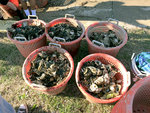 Severna Park
Severna ParkFair, 72°
Wind: 5.8 mph, S
 Severna Park
Severna Park



When Jason Port and his family moved to Severna Park about seven years ago, his son loved jumping in the waters of the Magothy River near their new home. Every time he went in the water, though, he would get a skin infection or irritation.
“I started doing a bunch of research on the river, the water quality and all that,” Port said.
Which is how he discovered the Chesapeake Bay Foundation’s oyster gardening program. No, they’re not growing oyster flowers. The program is designed to help establish a short-term habitat for oysters to hibernate over the winter and go from infancy to mature healthy oysters – kind of like an incubator - in a protected area.
“We started out with 40 pounds. Then the next year, we got a little bit more. And about two years later, he moved into Boy Scouting as an 11-year-old - Troop 450 in Severna Park here at St. Johns,” explained Port. “We brought the idea to these guys and said, ‘Look, if we were to scale this up, what would you think? Would you want to do this for a service project?’ It was a pretty resounding yes.”
A few years later, their effort has grown into the largest single emplacement by volunteers along the Chesapeake Bay, according to Port.
“Right now, we run about a ton to a ton and a half of oysters a year,” said Port.
To provide a winter home for thousands of pounds of young oysters, the team pieces together floats using PVC piping with cages that hang underneath where the oysters essentially hibernate until spring. Once the weather starts to warm up, the CBF takes the oysters to one of the designated reefs on the Magothy.
“In the spring, they bring a boat out and they take the boys and girls out to the reef and they dump [the oysters] out into the reef out there,” Port said. “It’s become a real production at the Cape Arthur beach every year.”
While the process requires a fair amount of work, the benefits to the bay and the Magothy are immeasurable, and Port encourages others to reach out to the Chesapeake Bay Foundation to learn about starting their own oyster garden.
“CBF has a great outreach program, and the education that they provide is really exceptional,” said Port. “It’s literally just small steps. Starting out with two small cages and 40 pounds of oysters and a willingness to participate. Even just that small amount can have a huge impact.
“The reality is if everyone who had a pier did this - even on a small scale - the impact would be significant.”
Comments
No comments on this item Please log in to comment by clicking here